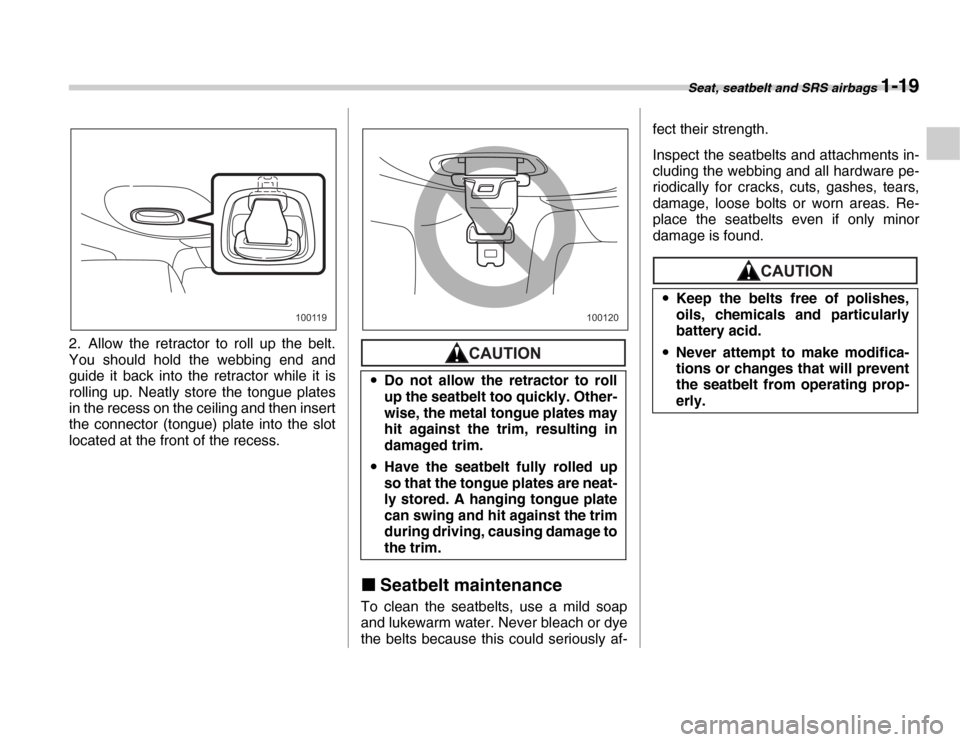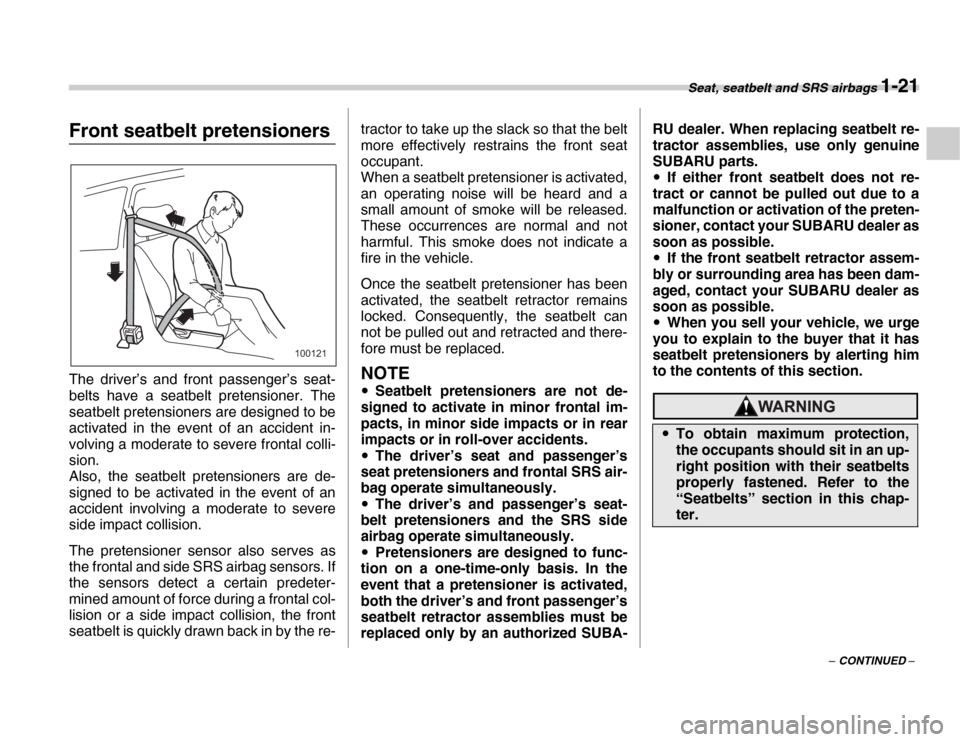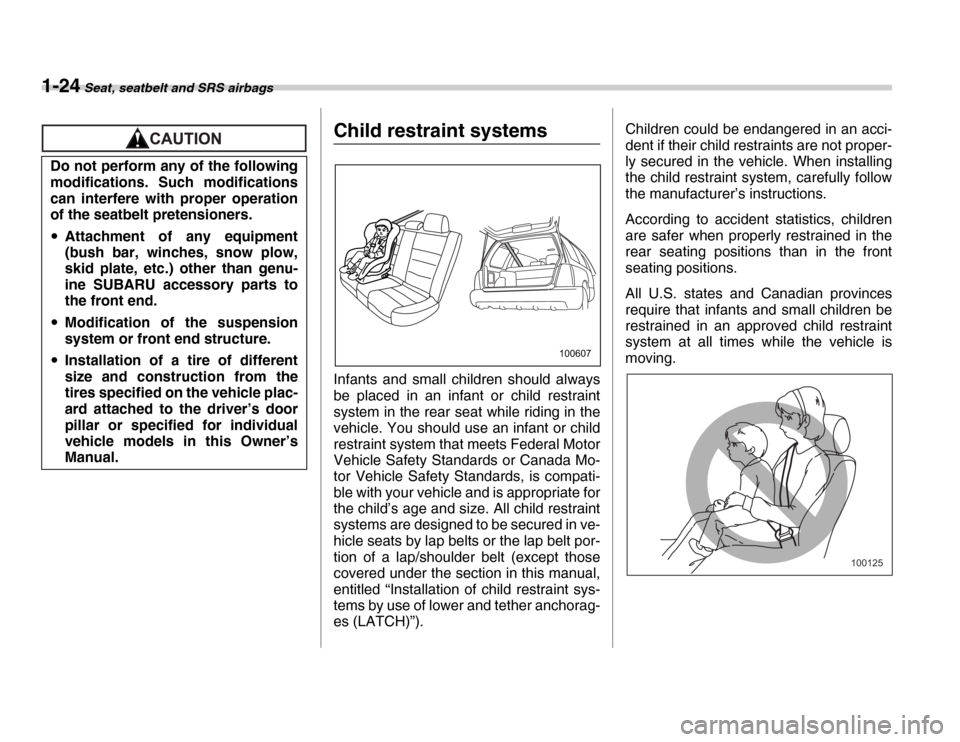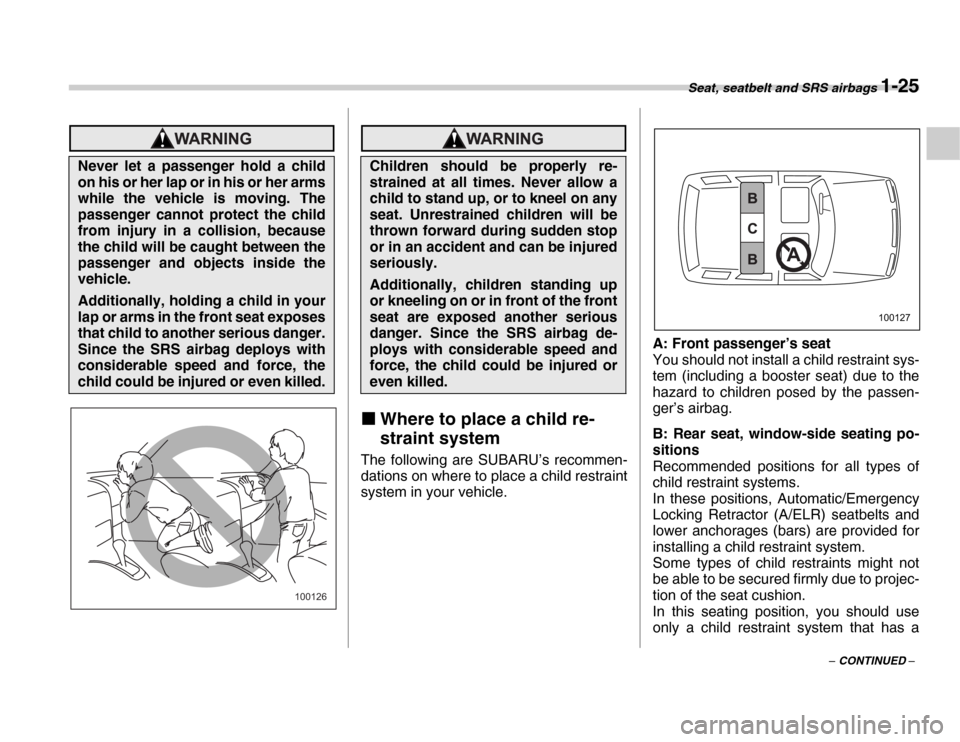2007 SUBARU FORESTER airbag
[x] Cancel search: airbagPage 47 of 356

Seat, seatbelt and SRS airbags 1-19
2. Allow the retractor to roll up the belt.
You should hold the webbing end and
guide it back into the retractor while it is
rolling up. Neatly store the tongue plates
in the recess on the ceiling and then insert
the connector (tongue) plate into the slot
located at the front of the recess.
�„Seatbelt maintenance
To clean the seatbelts, use a mild soap
and lukewarm water. Never bleach or dye
the belts because this could seriously af- fect their strength.
Inspect the seatbelts and attachments in-
cluding the webbing and all hardware pe-
riodically for cracks, cuts, gashes, tears,
damage, loose bolts or worn areas. Re-
place the seatbelts even if only minor
damage is found.
100119
�y
Do not allow the retractor to roll
up the seatbelt too quickly. Other-
wise, the metal tongue plates may
hit against the trim, resulting in
damaged trim.
�y Have the seatbelt fully rolled up
so that the tongue plates are neat-
ly stored. A hanging tongue plate
can swing and hit against the trim
during driving, causing damage to
the trim.
100120
�yKeep the belts free of polishes,
oils, chemicals and particularly
battery acid.
�y Never attempt to make modifica-
tions or changes that will prevent
the seatbelt from operating prop-
erly.
Page 48 of 356

1-20 Seat, seatbelt and SRS airbags
Seatbelt extender
If the front seatbelts are not long enough
to permit the tongue plate to engage with
the seatbelt buckle, an optional seatbelt
extender is available from your SUBARU
dealer. When ordering an extender, only
order one particularly designed for your
vehicle. Several different types of extend-
ers are available to match various variet-
ies of front seatbelt designs. See your
SUBARU dealer for assistance.
The extender adds approximately 8 inch-
es (200 mm) of length and it can be used
for either the driver or front passenger
seating position.
For the safety of others, the extender
should be removed after each use, espe-
cially if the next person using the seatbelt
does not need one.
Note that leaving the seatbelt extender’s
tongue plate engaged with the seatbelt
buckle may prevent the Subaru advanced
front airbag system from functioning cor-
rectly or cause the system to fail.
NOTE
When the seatbelt extender is used by a pregnant passenger, consult a doctor
to get approval in advance.
To connect the extender to the seatbelt,
insert the tongue plate into the seatbelt
buckle so that the “PRESS” signs on the
buckle-release buttons of the extender
and the seatbelt are both facing outward
as shown in the diagram. You will hear a
click when the tongue plate locks into the
buckle.
When releasing the seatbelt, press on the
buckle-release button on the extender, not
on the seatbelt. This helps to prevent
damage to the vehicle interior and extend-
er itself.
Be sure to observe the following
when using the seatbelt extender.
Failure to follow these instructions
and warnings could reduce the ef-
fectiveness of the seatbelt and re-
sult in more serious injury in the
event of a collision.
�y
Never use the extender when the
belt itself is long enough to permit
it to be buckled properly. If remov-
al of heavy clothing is all that is
needed to permit the seatbelt to
be buckled properly, remove the
heavy clothing and do not use the
extender.
�yDo not use the extender if the
buckle of the extender rests over
the abdomen.
�yDo not let someone else use the
extender. Use of an extender
when it is not needed could re-
duce the effectiveness of the seat-
belt and result in more serious in-
jury in the event of a collision.
�yUse the extender only for the front
seatbelts and only for the model
for which it was originally provid-
ed. Never use the extender for the
rear seatbelts or for a different
model.
100605
Page 49 of 356

Seat, seatbelt and SRS airbags 1-21
– CONTINUED –
Front seatbelt pretensioners
The driver’s and front passenger’s seat-
belts have a seatbelt pretensioner. The
seatbelt pretensioners are designed to be
activated in the event of an accident in-
volving a moderate to severe frontal colli-
sion.
Also, the seatbelt pretensioners are de-
signed to be activated in the event of an
accident involving a moderate to severe
side impact collision.
The pretensioner sensor also serves as
the frontal and side SRS airbag sensors. If
the sensors detect a certain predeter-
mined amount of force during a frontal col-
lision or a side impact collision, the front
seatbelt is quickly drawn back in by the re-tractor to take up the slack so that the belt
more effectively restrains the front seat
occupant.
When a seatbelt pretensioner is activated,
an operating noise will be heard and a
small amount of smoke will be released.
These occurrences are normal and not
harmful. This smoke does not indicate a
fire in the vehicle.
Once the seatbelt pretensioner has been
activated, the seatbelt retractor remains
locked. Consequently, the seatbelt can
not be pulled out and retracted and there-
fore must be replaced.
NOTE �y
Seatbelt pretensioners are not de-
signed to activate in minor frontal im-
pacts, in minor side impacts or in rear
impacts or in roll-over accidents. �y The driver’s seat and passenger’s
seat pretensioners and frontal SRS air-
bag operate simultaneously. �y The driver’s and passenger’s seat-
belt pretensioners and the SRS side
airbag operate simultaneously. �y Pretensioners are designed to func-
tion on a one-time-only basis. In the
event that a pretensioner is activated,
both the driver’s and front passenger’s
seatbelt retractor assemblies must be
replaced only by an authorized SUBA- RU dealer. When replacing seatbelt re-
tractor assemblies, use only genuine
SUBARU parts. �y
If either front seatbelt does not re-
tract or cannot be pulled out due to a
malfunction or activation of the preten-
sioner, contact your SUBARU dealer as
soon as possible. �y If the front seatbelt retractor assem-
bly or surrounding area has been dam-
aged, contact your SUBARU dealer as
soon as possible.�y When you sell your vehicle, we urge
you to explain to the buyer that it has
seatbelt pretensioners by alerting him
to the contents of this section.
100121
�y To obtain maximum protection,
the occupants should sit in an up-
right position with their seatbelts
properly fastened. Refer to the
“Seatbelts” section in this chap- ter.
Page 50 of 356

1-22 Seat, seatbelt and SRS airbags
�„System monitors
A diagnostic system continually monitors
the readiness of the seatbelt pretensioner
while the vehicle is being driven. The seat-
belt pretensioners share the control mod-
ule with the SRS airbag system. There-
fore, if any malfunction occurs in a seat-
belt pretensioner, the SRS airbag system
warning light will illuminate. The SRS air-
bag system warning light will show normal
system operation by lighting for approxi-
mately 6 seconds when the ignition switch
is turned to the “ON” position.
The following components are monitored
by the indicator: �y Front sub sensor (Right-hand side)
�y Front sub sensor (Left-hand side)
�y Airbag control module (including impact sensors) �y
Frontal airbag module (Driver’s side)
�y Frontal airbag module (Front passen-
ger’s side)�y Side airbag sensor (Center pillar right-
hand side) �y Side airbag sensor (Center pillar left-
hand side)�y Side airbag module (Driver’s side)
�y Side airbag module (Front passenger’s
side)�y Seatbelt pretensioner (Driver’s side)
�y Seatbelt pretensioner (Front passen-
ger’s side) �y Seatbelt buckle switch (Driver’s side)
�y Seatbelt buckle switch (Front passen-
ger’s side) �y Driver’s seat position sensor
�y Front passenger’s seatbelt tension sen-
sor (if equipped)�y Front passenger’s occupant detection
system weight sensor �y Front passenger’s occupant detection
control module �y Front passenger’s frontal airbag ON
and OFF indicator �y All related wiring�y Do not modify, remove or strike
the front seatbelt retractor assem-
blies or surrounding area. This
could result in accidental activa-
tion of the seatbelt pretensioners
or could make the system inoper-
ative, possibly resulting in seri-
ous injury. Seatbelt pretensioners
have no user-serviceable parts.
For required servicing of front
seatbelt retractors equipped with
seatbelt pretensioners, see your
nearest SUBARU dealer.
�yWhen discarding front seatbelt re-
tractor assemblies or scrapping
the entire vehicle due to collision
damage or for other reasons, con-
sult your SUBARU dealer.100606
Page 51 of 356

Seat, seatbelt and SRS airbags 1-23
– CONTINUED –
�„System servicing
NOTE
If the front part of the vehicle is dam-
aged in an accident to the extent that
the seatbelt pretensioner does not op-
erate, contact your SUBARU dealer as
soon as possible. �„ Precautions against vehicle
modification
Always consult your SUBARU dealer if
you want to install any accessory parts to
your vehicle.
If the warning light exhibits any of
the following conditions, there may
be a malfunction in the seatbelt pre-
tensioners and/or SRS airbag sys-
tem. Immediately take your vehicle
to your nearest SUBARU dealer to
have the system checked. Unless
checked and properly repaired, the
seatbelt pretensioners and/or SRS
airbags will not operate properly in
the event of a collision, which may
increase the risk of injury.
�y Flashing or flickering of the warn-
ing light
�yNo illumination of the warning
light when the ignition switch is
first turned to the “ON” position
�yContinuous illumination of the
warning light
�yIllumination of the warning light
while driving
�y When discarding a seatbelt retrac-
tor assembly or scrapping the en-
tire vehicle damaged by a colli-
sion, consult your SUBARU deal-
er.
�yTampering with or disconnecting
the system’s wiring could result in
accidental activation of the seat-
belt pretensioner and/or SRS air-
bag or could make the system in-
operative, which may result in se-
rious injury. The wiring harnesses
of the seatbelt pretensioner and
SRS airbag systems are covered
with yellow insulation and the
connectors of the system are yel-
low for easy identification. Do not
use electrical test equipment on
any circuit related to the seatbelt
pretensioner and SRS airbag sys-
tems. For required servicing of
the seatbelt pretensioner, see
your nearest SUBARU dealer.
The front sub sensors are located
near the bottom of the radiator and
the side airbag sensor is located in-
side each center pillar and the SRS
airbag control module including the
impact sensors is located under the
center console. If you need service
or repair in those areas or near the
front seatbelt retractors, we recom-
mend that you have an authorized
SUBARU dealer perform the work.
Page 52 of 356

1-24 Seat, seatbelt and SRS airbags
Child restraint systems
Infants and small children should always
be placed in an infant or child restraint
system in the rear seat while riding in the
vehicle. You should use an infant or child
restraint system that meets Federal Motor
Vehicle Safety Standards or Canada Mo-
tor Vehicle Safety Standards, is compati-
ble with your vehicle and is appropriate for
the child’s age and size. All child restraint
systems are designed to be secured in ve-
hicle seats by lap belts or the lap belt por-
tion of a lap/shoulder belt (except those
covered under the section in this manual,
entitled “Installation of child restraint sys-
tems by use of lower and tether anchorag-
es (LATCH)”).Children could be endangered in an acci-
dent if their child restraints are not proper-
ly secured in the vehicle. When installing
the child restraint system, carefully follow
the manufacturer’s instructions.
According to accident statistics, children
are safer when properly restrained in the
rear seating positions than in the front
seating positions.
All U.S. states and Canadian provinces
require that infants and small children be
restrained in an approved child restraint
system at all times while the vehicle is
moving.
Do not perform any of the following
modifications. Such modifications
can interfere with proper operation
of the seatbelt pretensioners. �y
Attachment of any equipment
(bush bar, winches, snow plow,
skid plate, etc.) other than genu-
ine SUBARU accessory parts to
the front end.
�y Modification of the suspension
system or front end structure.
�y Installation of a tire of different
size and construction from the
tires specified on the vehicle plac-
ard attached to the driver’s door
pillar or specified for individual
vehicle models in this Owner’s
Manual.
100607
100125
Page 53 of 356

Seat, seatbelt and SRS airbags 1-25
– CONTINUED –
�„Where to place a child re-
straint system
The following are SUBARU’s recommen-
dations on where to place a child restraint
system in your vehicle. A: Front passenger’s seat
You should not install a child restraint sys-
tem (including a booster seat) due to the
hazard to children posed by the passen-
ger’s airbag.
B: Rear seat, window-side seating po-
sitions
Recommended positions for all types of
child restraint systems.
In these positions, Automatic/Emergency
Locking Retractor (A/ELR) seatbelts and
lower anchorages (bars) are provided for
installing a child restraint system.
Some types of child restraints might not
be able to be secured firmly due to projec-
tion of the seat cushion.
In this seating position, you should use
only a child restraint system that has a
Never let a passenger hold a child
on his or her lap or in his or her arms
while the vehicle is moving. The
passenger cannot protect the child
from injury in a collision, because
the child will be caught between the
passenger and objects inside the
vehicle.
Additionally, holding a child in your
lap or arms in the front seat exposes
that child to another serious danger.
Since the SRS airbag deploys with
considerable speed and force, the
child could be injured or even killed.
100126
Children should be properly re-
strained at all times. Never allow a
child to stand up, or to kneel on any
seat. Unrestrained children will be
thrown forward during sudden stop
or in an accident and can be injured
seriously.
Additionally, children standing up
or kneeling on or in front of the front
seat are exposed another serious
danger. Since the SRS airbag de-
ploys with considerable speed and
force, the child could be injured or
even killed.
100127
Page 54 of 356

1-26 Seat, seatbelt and SRS airbags
bottom base that fits snugly against the
contours of the seat cushion and can be
securely retained using the seatbelt.
C: Rear seat, center seating position
Installing a child restraint system is not
recommended, although the A/ELR seat-
belt and an upper anchorage (tether an-
chorage) are provided in this position.
Some types of child restraints might not
be able to be secured firmly due to projec-
tion of the seat cushion.
In this seating position, you should use
only a child restraint system that has a
bottom base that fits snugly against the
contours of the seat cushion and can be
securely retained using the seatbelt.
�„Choosing a child restraint
system
Choose a child restraint system that is ap-
propriate for the child’s age and size
(weight and height) in order to provide the
Put children aged 12 and under in
the rear seat properly restrained at
all times. The SRS airbag deploys
with considerable speed and force
and can injure or even kill children,
especially if they are 12 years of age
and under and are not restrained or
improperly restrained. Because chil-
dren are lighter and weaker than
adults, their risk of being injured
from deployment is greater.
Consequently, be sure to secure
ALL types of child restraint devices
(including forward facing child
seats) in the REAR seats at all times.
You should choose a restraint de-
vice which is appropriate for the
child’s age, height and weight. Ac-
cording to accident statistics, chil-
dren are safer when properly re-
strained in the rear seating posi-
tions than in the front seating posi-
tions.
100608
SINCE YOUR VEHICLE IS
EQUIPPED WITH A PASSENGER’S
SRS AIRBAG, NEVER INSTALL A
REARWARD FACING CHILD SAFE-
TY SEAT IN THE FRONT PASSEN-
GER’S SEAT. DOING SO RISKS SE-
RIOUS INJURY OR DEATH TO THE
CHILD BY PLACING THE CHILD’S
HEAD TOO CLOSE TO THE SRS
AIRBAG.
100502